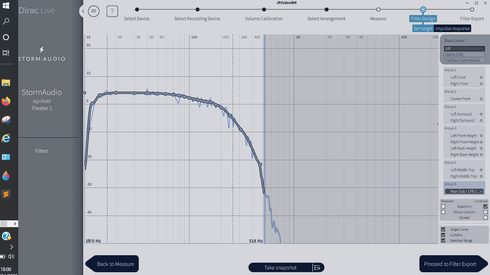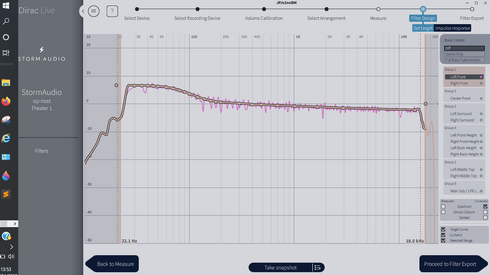That's very interesting - thank you so much. As it happens I have been using a 100hz global crossover on the Arcam until the Storm arrived about ten days ago and I always found that that produced the best results in my room with that processor.
Alas I am unable to alter the speaker positions as they are aligned to the projection screen and one is in a corner. I will reset the crossover to 100hz and remeasure.
I appear to be one of the first people in the world (if not the first person) with the new Dirac Bass Management module and there are a number of people wanting to know if it fulfills it's claims. You run this after you set your curve and it calculates it's optimal crossovers. In my case these came out as follows:-
Mains 34hz (S3900s)
Centre 52Hz (Revel S16)
Surrounds 59Hz (Audiovector M1 Signature)
Heights 64hz (FH Revel S16 RH MK Sound ss150 tripoles)
Ceiling Atmos Mid Top 27hz!! (Monitor Audio)
Apart from the nonsensical proposed Xover for the in ceiling pair, your own anaysis would appear to indicate that these Xovers are unlikely to produce a good result in my room. If that's the case future users will need to be aware of that I think.
Fortunately, you can move the crossovers to your choice and recalculate the filters so I have tried this and saved the profile. I now have three profiles:-
1. 100hz crossovers no BM
2. Dirac BM calculated Xovers as above
3. Dirac BM reset to 100hx crossovers
I will attempt to load each one in turn and carry out the REW measurements from the same initial Dirac mic position and forward over the MDATs for each.
Interestingly Diirac has not altered the delays at all which would indicate that we are still going to have to revisit the delay question once the optimal crossover is found - as from what I understand from your analysis it seems that we need to determine the optimal crossover before we look again at whether the delays calculated by Dirac are correct/optimal themselves.
I have attached some screenshots that show what Dirac is doing.
Calculating takes 5 mins or so
This is what dirac calculates crossovers at - see column on right. These show the uncorrected measurements
This shows the corrected curve after Dirac or at least purports to!
Same for centre
And for heights with that 27hz choice of crossover
This is what you see when you move the Xover up to 100hx - a new calculation is now needed
And now after that recalculation with crossover at 100hz - this is for mains as you can see on right
This shows delays have not changed from first Dirac measurement without any BM applied















